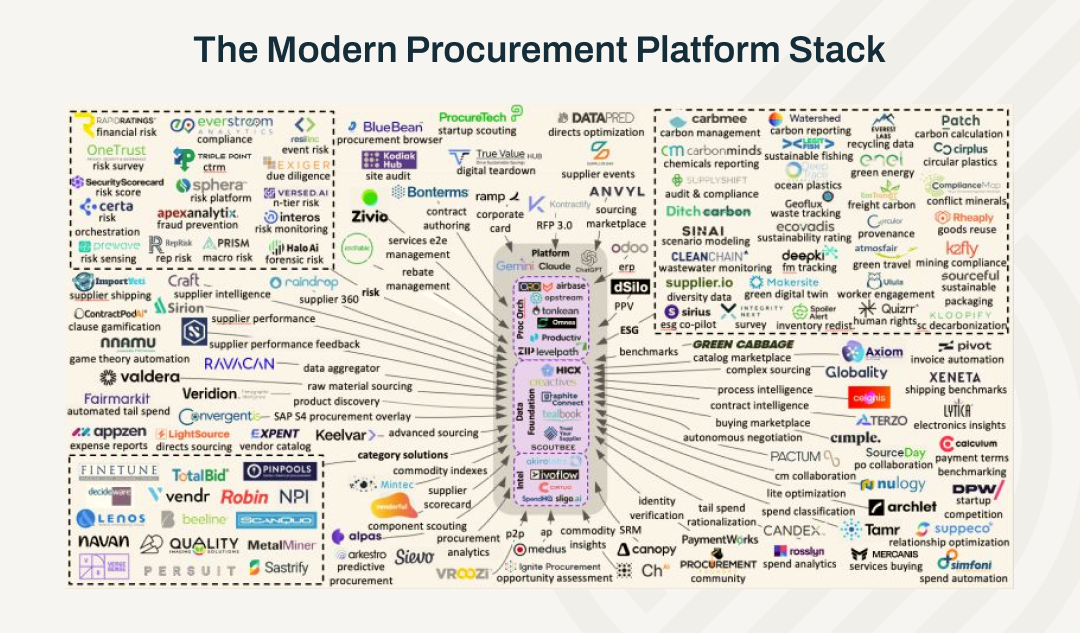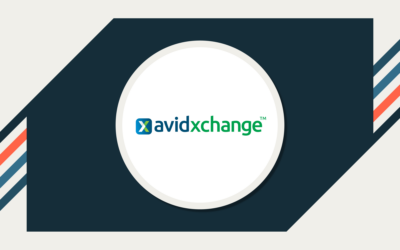Modern finance departments need modern procurement solutions that automate processes, provide insights into spending, and simplify budgeting and planning.
These tools do three important things:
1. Enhance operational efficiency.
2. Improve spend visibility.
3. Drive significant cost savings.
Here, we explore the top procurement solutions for finance teams in 2024, with detailed comparisons of features, benefits, and best-use cases.
TL; DR: Finance teams that operate with sophisticated procurement systems tap into automation and real-time insights. Better spending visibility informs purchase insights and simplifies budget forecasts. Here are eight industry-leading procurement solutions that streamline processes, minimize manual tasks like data entry and reconciliation, and optimize the procure-to-pay cycle: Airbase, Coupa, JAGGAER, Precoro, SAP Ariba, Tipalti, Vendr, and Zip.
Dr. Elouise Epstein publishes her spider map of all procurement-related software each year. There are literally hundreds of them but, here, we focus on eight that offer a broad procure-to-pay experience.

What is a procurement solution?
Advanced, comprehensive procurement solutions are essential for finance teams looking to optimize the procure-to-pay cycle. This cycle includes all activities involved in purchasing goods and services, as well as the associated financial transactions.
These solutions provide a structured approach to managing spend, ensuring that purchases align with business policies and budgets. By consolidating procurement data and activities into one platform, finance teams gain actionable insights that lead to better strategic decisions and improved vendor management.
Additionally, advanced procurement solutions come equipped with features like spend forecasting and market analysis, which are invaluable for planning and budgeting. Organizations stay competitive by quickly adapting to market changes and supply chain disruptions.
The seamless integration of procurement software with existing systems enhances overall business efficiency. As a result, finance teams spend less time on manual data entry and reconciliation tasks, minimizing the likelihood of errors.
Expense optimization.
By implementing a robust procurement solution, organizations automate cost tracking and analysis, and significantly enhance expense management. This automation allows companies to swiftly identify areas to reduce or optimize spending.
For instance, dynamic budgeting tools within these solutions alert procurement teams to budget variances in real time, prompting immediate adjustments. In addition, the integration of e-procurement solutions with supplier databases enables organizations to leverage historical data to negotiate better terms and bulk discounts, further driving down costs.
In addition to cost control, procurement management software helps businesses maintain a lean inventory. They optimize stock levels based on predictive analytics, which prevents overstock and stockouts. This maintains a balance that supports uninterrupted operations without tying up unnecessary capital in inventory. It’s a strategic approach to inventory management that boosts profitability and supports sustainability by reducing waste.
Automate the procurement processes.
The automation of procurement processes extends beyond simplifying transactions. It incorporates sophisticated algorithms that predict needs based on historical buying patterns and current market trends. This predictive capability ensures that businesses maintain an optimal inventory level and make purchases at the most cost-effective times.
Automated workflows also facilitate faster procurement cycles, which are critical in time-sensitive industries where the speed of supply chain operations can be a significant competitive advantage.
In addition, automation enhances transparency in procurement activities.
Every transaction, from request to receipt, is recorded in real time, providing finance teams with immediate visibility into expenditures.
This transparency is crucial for compliance with internal audits and regulatory requirements, and it also fosters accountability among staff. Automated alerts notify procurement managers of discrepancies or unauthorized purchases, reinforcing control measures and protecting against fraud.

Guided Procurement Tour
Explore our automated procurement workflows in the Guided Procurement tour.
Strategic supplier relationship management (SRM).
Strategic supplier relationship management (SRM) is vital for maintaining a reliable and high-performing supply chain.
Procurement software facilitates deeper collaboration with suppliers by sharing forecasts, production plans, and market changes, which helps both parties align their objectives and expectations. This collaboration can lead to innovations in product development and improvements in supply chain logistics, creating a competitive edge for the company.
Additionally, these platforms often include supplier performance management tools that track metrics like delivery timeliness, product quality, and responsiveness. This data is essential for evaluating supplier relationships and making data-informed decisions when it comes to contract renewals. By systematically managing these relationships, companies can achieve greater operational flexibility and resilience, particularly in volatile market conditions.
Risk mitigation.
Advanced procurement solutions also provide comprehensive risk management features designed to identify and address potential risks at every stage of the procurement process. These include financial risks like price fluctuations and non-compliance with budget approvals, as well as operational risks like supply chain interruptions and quality issues with received goods. Advanced analytics provide risk assessments that help companies make more informed decisions about their procurement strategies.
Risk mitigation also involves enhancing security measures to protect sensitive data related to procurement activities. Encryption, access controls, and audit trails help safeguard information against unauthorized access and cyber threats.
This security is critical for protecting the company’s financial interests and for maintaining its reputation and compliance with data protection regulations. These protective measures ensure that the procurement process is both secure and robust, allowing companies to operate with confidence.
1. Airbase.
Airbase is an advanced procure-to-pay solution that integrates accounts payable, expense management, and corporate cards into a comprehensive spend management platform, simplifying purchasing across your entire organization. Its intake capabilities are second to none and allow for complex stakeholder collaboration either in Airbase or in their own software via integrations.
This comprehensive yet flexible solution streamlines workflows, reduces processing times, and enhances visibility into all non-payroll expenditures. Airbase is particularly effective in environments that value robust analytics and real-time data for decision-making.
The platform offers an exceptional user experience that promotes higher adoption rates and better compliance across departments.
Airbase’s Guided Procurement manages the entire procurement process and provides strategic insights that influence company-wide spending decisions. It’s built to accommodate rapid scaling, making it an ideal choice for growing companies that anticipate future expansion. Airbase’s mobile app gives remote users access to manage spending anytime, anywhere.
Key Features:
- Unified spend management platform.
- Real-time data synchronization with ERP systems.
- APIs for and integrations into other business systems (HRIS, Jira, Asana, Slack, etc.).
- Automated invoice processing and expense management.
- Comprehensive corporate card integration.
- Advanced approval workflows and policy compliance.
- Extensive vendor management capabilities.
- Mobile application for on-the-go management.
Limitations:
- No support for supply chain management.
- Higher cost compared to some entry-level solutions.
- Requires training for advanced features.
Best for:
Small, mid-market, and early enterprise organizations that need quick time-to-value and a robust, integrated financial management solution that can scale as they grow.

2. Coupa.
Coupa offers a comprehensive suite of business spend management solutions that integrate procurement functions, invoicing, and expense handling into a single platform. This holistic approach allows Coupa to provide exceptional visibility across all spend categories. It’s a preferred choice for enterprises that need to manage complex budgets and regulatory requirements.
It’s cloud-based, so it scales to meet the demands of any size of business, facilitating global operations without the need for significant IT infrastructure.
Key features:
- Comprehensive spend management from procurement to payment.
- Strategic sourcing and supplier management.
- Contract lifecycle management.
- Real-time budget management and analytics.
- Advanced policy enforcement tools.
Limitations:
- Complex and long implementation process.
- Expensive for smaller organizations.
- Requires significant change management for full adoption.
Best for:
Large enterprises with complex procurement needs that benefit from a wide range of functionalities.
3. JAGGAER.
JAGGAER specializes in higher education and government sectors. Tailored solutions include advanced sourcing, procurement, and spend analytics. It’s designed to handle the complex procurement requirements associated with large-scale projects and contracts.
The platform also offers flexible customization to meet the unique demands of a variety of users, promoting an efficient procurement process for an organization’s specific workflows.
Key features:
- Specialized solutions for specific industry sectors.
- Advanced sourcing and bid management.
- Spend analysis and category management.
- Supplier management and compliance tracking.
Limitations:
- Customer support experiences vary.
- Interface may not be as intuitive as competitors.
- Primarily suited for large organizations and specific industries.
Best for:
Organizations that prioritize strategic sourcing and deep spend analysis.
4. Precoro.
Precoro prioritizes simplicity and efficiency, making it ideal for small to mid-market businesses. The platform’s effective cost-control mechanisms streamline procurement processes.
Plus, its user-friendly interface makes it easy to pick up and use without extensive training. Precoro’s real-time budget monitoring and automated alerts keep spending under control, enhancing financial oversight.
Key Features:
- User-friendly interface with a low barrier to entry.
- Real-time spend data and cost tracking.
- Automated procurement workflows.
- Integration with popular accounting software.
Limitations:
- Limited functionality for complex global supply chains.
- May not scale as well as other solutions designed for larger organizations.
Best for:
Small to mid-market businesses looking for straightforward procurement solutions.
5. SAP Ariba.
SAP Ariba offers a robust cloud-based solution for managing global procurement and supply chain activities. Large enterprises especially appreciate its comprehensive features that support the entire procurement lifecycle, from sourcing to settlement. It also includes powerful analytics to drive smarter spending decisions.
The platform’s network capabilities connect businesses with millions of suppliers worldwide, facilitating better collaboration and innovation in the supply chain.
Key features:
- Extensive global supply chain management capabilities.
- Comprehensive sourcing and procurement functions.
- Integrated contract management.
- Detailed spend analysis and supplier risk assessment.
- Strong compliance and control mechanisms.
Limitations:
- Complex implementation and integration process.
- High total cost of ownership.
- May require extensive training for users.
Best for:
Large organizations needing a comprehensive, global procurement solution.
6. Tipalti.
Tipalti automates the entire accounts payable process, making it easier for companies to manage global supplier payments. Its key strength lies in its ability to streamline mass payment processes and reduce payment reconciliation and compliance workloads, which is particularly valuable for companies dealing with high-volume international transactions. The platform also offers multi-currency support, simplifying foreign exchanges.
Key Features:
- Global AP automation.
- Mass payment capabilities across different countries and currencies.
- Tax compliance and regulatory adherence features.
- Supplier management portal.
Limitations:
- Focused more on payables than the broader procurement process.
- Some users may find the platform lacks customization flexibility.
- Integration with an existing ERP system can be challenging.
Best for:
Businesses with heavy global supplier payments needing streamlined payment processing.
7. Vendr.
Vendr has revolutionized the way companies purchase and renew software. It offers a SaaS management platform that focuses on reducing the costs associated with software subscriptions.
This specialized focus makes Vendr a go-to solution for tech companies looking to optimize their software expenditures. With a clear emphasis on cost reduction and efficiency. Vendr provides a streamlined approach that directly impacts tech organizations’ bottom lines.
Key features.
- SaaS procurement and cost optimization.
- Negotiation and management of software contracts.
- Real-time tracking of software spend and usage.
- Vendor compliance and risk management.
Limitations:
- Limited to software purchases, not suitable for broader procurement needs.
- May not be ideal for non-tech companies.
- Lacks the depth in features for managing physical goods procurement.
Best for:
Tech companies looking to optimize their SaaS expenditures.
8. Zip.
Zip’s procurement solution excels in decentralized environments, helping companies empower their employees while maintaining control over spend. It’s designed to facilitate quick decisions and approvals, which is ideal for fast-paced and growth-oriented companies. This flexible procurement platform adapts to the varied needs of different departments, enabling a more dynamic and responsive approach to spending across the company.
Key Features:
- Facilitates decentralized procurement processes.
- Quick setup and ease of use.
- Integration with various business tools for streamlined operations.
- Flexible and dynamic approval processes.
Limitations:
- May require additional systems for complete financial management.
- Some users report issues with customization and flexibility.
- Not suited for companies looking for deep procurement analytics.
Best for:
Agile, fast-growing companies that value speed and flexibility in their procurement processes.
Upgrade your procurement system with Airbase.
The right e-procurement solution gives finance teams insight and financial control. If you’re looking for a procure-to-pay solution to streamline purchasing processes, enhance vendor management, and deliver incredible cost savings, Airbase is the top pick for mid-market to large organizations.
“The UI is great, easy to use. Better than competitors in the space in our opinion. Great user adoption from our team for approvals and spend requests. Easy ledger integration. It’s been a great experience.” — G2 review
Airbase simplifies purchasing operations, increases visibility, and improves compliance. With Airbase, you’ll gain a holistic view of your company’s spend — every dollar spent is optimized for maximum return.
Schedule a free Airbase demo today and see what a unified procure-to-pay solution can do for your business.
 Jira
Jira  Ironclad
Ironclad  Asana
Asana 




